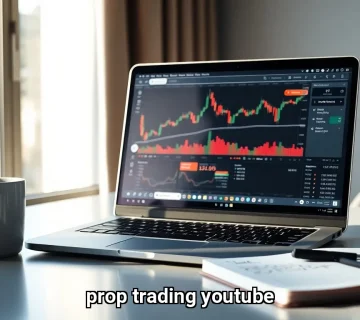Imagine seizing the chance to trade financial markets with substantial capital, risk-free to your own funds, while retaining a hefty portion of the profits. This captures the core of Prop Trading Explained—a dynamic and sophisticated method where financial firms deploy their own capital to profit from market movements in prop trading. Unlike traditional brokers acting for clients, prop trading firms use their own resources, empowering traders to pursue varied strategies, from high-frequency trades to long-term positions, backed by cutting-edge technology and rigorous risk controls.
Whether you’re a seasoned trader looking to scale up or someone curious about how financial institutions generate profits beyond client commissions, understanding prop trading offers valuable insight into a unique corner of the trading world. In this article, we’ll break down the fundamentals of prop trading, how it operates, its benefits, and the risks involved. By the end, you’ll have a clear overview of what proprietary trading entails and how traders can harness its potential through specialized platforms and structured programs. If you’re ready to explore a trading path that combines opportunity with responsibility, keep reading to discover how prop trading works and why it continues to attract ambitious traders globally.
What Is Proprietary Trading?
Proprietary trading, commonly known as prop trading, involves a financial institution or prop trading firm using its own capital to trade financial instruments, rather than executing trades on behalf of clients. This fundamental difference allows the firm to retain the entirety of the profits or absorb any losses generated by trading activities. Unlike brokerage firms that earn commissions by facilitating trades for clients, prop trading firms put their own balance sheets at risk to capitalize on market opportunities.
Prop trading desks typically operate independently within larger financial entities, separated from client-facing divisions to prevent conflicts of interest. This autonomy enables prop traders to deploy a wide variety of trading strategies, ranging from high-frequency trading and statistical arbitrage to macroeconomic trend analysis and volatility plays. The goal is straightforward: maximize returns using the firm’s capital with the support of advanced technology and risk management systems.

How Does Prop Trading Work?
When a trader joins a proprietary trading firm, they are allocated a specific amount of capital, which they use to place trades in the market. The size of the allocated capital and the trader’s share of the profits depend on their experience, past performance, and the firm’s policies. For instance, some firms may offer profit splits where traders retain 40-60% of gains, while the firm keeps the remainder to cover operational costs and risk exposure.
The trader enjoys considerable freedom in choosing trading strategies, but within the framework of strict risk management rules imposed by the firm. These guidelines are designed to protect the firm’s capital and ensure sustainable profitability. For example, limits on maximum daily losses, position sizes, and drawdowns are typical constraints prop traders must respect.
Prop trading strategies vary widely. Some traders focus on short-term techniques such as day trading or scalping, capitalizing on small price fluctuations. Others adopt longer-term approaches like swing or position trading, leveraging fundamental analysis or technical indicators. Arbitrage strategies—such as index arbitrage, merger arbitrage, or volatility arbitrage—are also common, exploiting price inefficiencies across markets or securities.
Benefits of Prop Trading Explained
Prop trading offers several compelling benefits for both financial institutions and individual traders:
- Access to Significant Capital
One of the most attractive features of prop trading is the access to substantial capital, often far exceeding what a retail trader could manage independently. This capital allows traders to take larger positions, diversify across multiple instruments, and amplify potential profits without risking personal funds. - Advanced Trading Technology and Tools
Proprietary trading firms invest heavily in cutting-edge trading platforms, real-time market data, and sophisticated order execution systems. This infrastructure provides traders with faster, more efficient access to markets and analytical capabilities, increasing the likelihood of profitable trades. - Comprehensive Training and Support
Many prop trading firms offer mentorship programs, risk management training, and ongoing educational resources. This support helps traders refine their skills, develop robust strategies, and better understand market dynamics. - Enhanced Profit Potential
Because traders use the firm’s capital, they can potentially generate higher returns than would be feasible with their own limited funds. Profit-sharing arrangements often reward traders generously for their success, motivating high performance. - Liquidity Provider Role
Proprietary trading desks often become influential market makers by providing liquidity for specific securities or asset classes. This role benefits both the firm and its clients by facilitating smoother trading and reducing market volatility. - Experience in Professional Trading Environment
Trading with a prop firm exposes traders to real market conditions and professional-grade risk management protocols. This experience is invaluable for those aspiring to build a long-term career in trading.

Risks Associated with Prop Trading
Despite its advantages, prop trading carries notable risks that traders must understand:
- Potential for Significant Losses
Trading with large amounts of capital increases the scale of potential losses. Although risk management rules are in place, traders who mismanage positions can cause substantial financial damage to the firm and risk losing their trading privileges. - Profit Sharing and Fees
Unlike trading with personal funds, prop traders do not keep 100% of their profits. Firms retain a portion of the gains as compensation for providing capital and infrastructure. Additionally, some firms charge fees for software use, data subscriptions, or platform access, which can erode net earnings. - Strict Risk Management Restrictions
Prop firms impose rigorous controls on trading activities to protect assets. These may limit certain strategies or impose drawdown limits that can frustrate traders who prefer more flexibility. - Operational and Transparency Concerns
The prop trading industry includes a variety of firms, some less reputable than others. Traders must conduct thorough due diligence to avoid scams or firms that make unrealistic promises about profit potential or account scaling. - Regulatory Limitations
Large banks and financial institutions face regulatory restrictions such as the Volcker Rule, which limits proprietary trading to reduce systemic risk. This regulatory environment can impact the scale and types of prop trading activities permitted.
Prop Trading Platforms and Opportunities
The rise of specialized prop trading platforms has expanded opportunities for traders worldwide. These platforms provide access to virtual or real capital, advanced analytics, and community support. Propx Pro is an example of a platform designed to cater to the unique needs of prop traders, offering features like commission-free trading, integrated charting tools, and a built-in trade copier. Such platforms aim to create an immersive trading environment where traders can focus on strategy and execution without worrying about operational hurdles.
Prop trading platforms often feature profit-sharing models that reward successful traders generously. For instance, some firms provide splits as high as 90% in favor of the trader, reflecting confidence in their abilities and incentivizing performance. They also offer demo accounts or trial periods, enabling traders to familiarize themselves with the platform and test strategies before committing real capital.
How to Get Started in Prop Trading
Entering the world of prop trading requires a combination of skill, discipline, and due diligence. Here are practical steps for aspiring prop traders:
- Research Prop Firms Carefully
Investigate the firm’s reputation, fee structure, profit-sharing agreements, and support services. Reading reviews and seeking recommendations can help identify trustworthy firms. - Develop a Proven Trading Strategy
Successful prop traders typically have well-tested strategies with positive historical performance. Backtesting and forward-testing strategies help build confidence and demonstrate value to prop firms. - Meet Entry Requirements
Some firms require passing evaluations or screening processes that assess risk management, consistency, and trading discipline. Preparing for these assessments is essential. - Manage Risk Meticulously
Adhering to strict risk management guidelines is crucial in preserving capital and maintaining trading privileges. This includes using stop-loss orders, appropriate position sizing, and avoiding over-leveraging. - Leverage Educational Resources
Utilize training programs, webinars, and mentorship opportunities offered by prop firms or independent educators to enhance trading skills. - Stay Adaptable and Disciplined
Markets are dynamic, and prop trading demands continuous learning and emotional control. Discipline in following rules and adapting to changing conditions is vital.

Prop Trading Explained: Real-World Example
Consider a trader who joins a prop firm and is allocated $100,000 of capital. They employ a swing trading strategy focusing on tech stocks. Over a quarter, the trader generates $20,000 in profits. With a profit-sharing agreement of 50%, the trader pockets $10,000, while the firm retains the other $10,000. The trader does not risk personal capital, yet benefits from substantial exposure and professional resources.
The firm benefits by boosting its earnings without deploying additional staff or capital, while the trader gains experience and income potential. Platforms like Propx Pro simplify this process by offering seamless technology and supportive infrastructure, making prop trading accessible to a wider audience.
Unlocking the Potential of Proprietary Trading
Proprietary trading stands out as a compelling avenue for traders eager to leverage substantial capital, cutting-edge technology, and professional support—all while sharing in the rewards of their market acumen. This unique model empowers traders to operate with enhanced financial backing and strategic freedom, yet it demands disciplined risk management and thorough due diligence to navigate its inherent challenges successfully.
By embracing the insights and best practices outlined here, aspiring prop traders can confidently approach this sophisticated trading landscape, poised to capitalize on its opportunities with responsibility and skill. As prop trading continues to evolve alongside innovative platforms like Propx Pro, it opens doors for ambitious traders worldwide to transform their market strategies into sustainable, profit-driven careers.




No comment